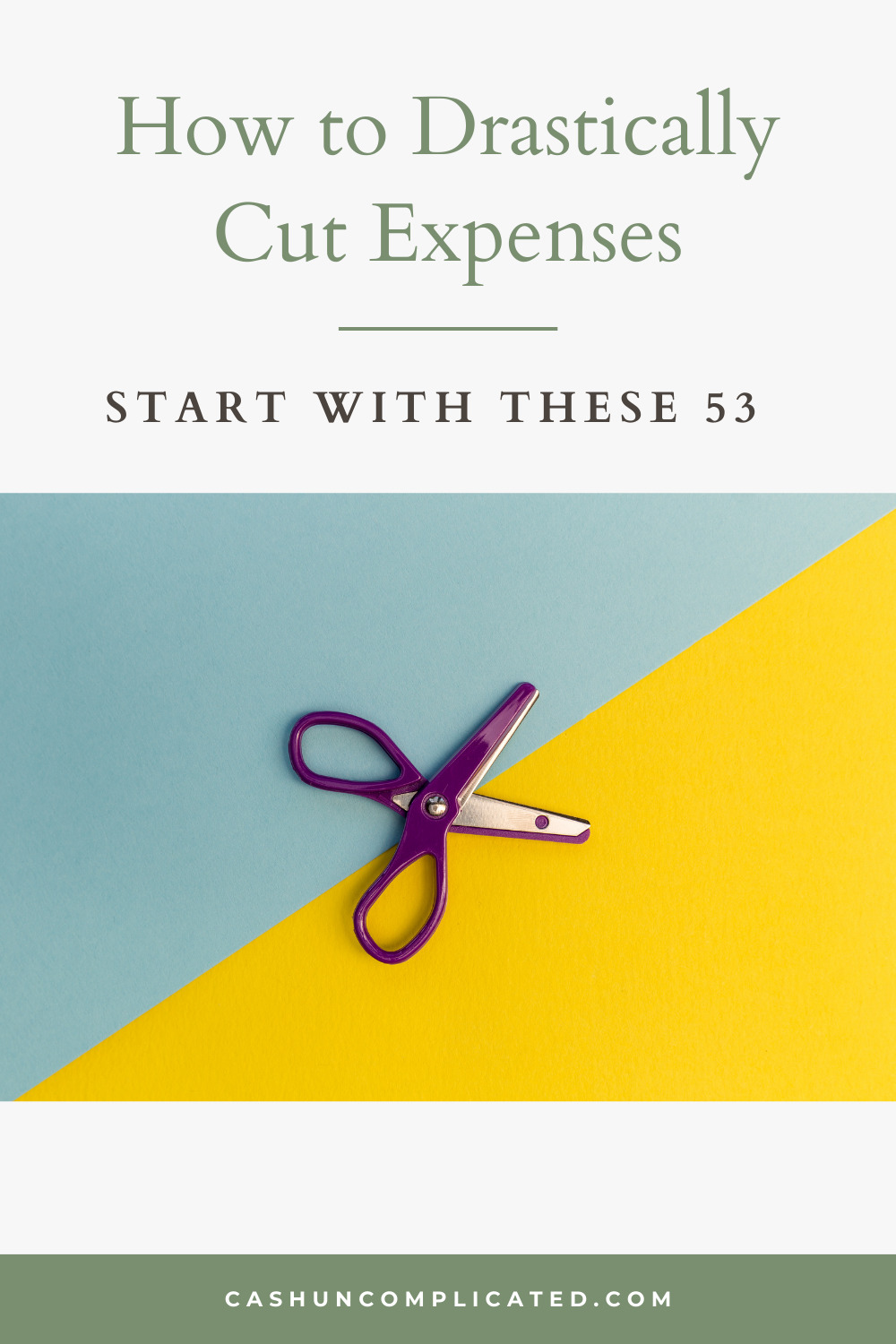Sometimes we reach a boiling point and decide enough is enough. Maybe you’ve been living under financial stress for years and don’t want to do it anymore. Or maybe your values and priorities have changed. Whatever the reason, you’re at the point where you want to drastically cut expenses.
I’m not a big proponent of financial “crash diets” because I fear there will be short term success followed by reverting to old financial behaviors. Followed by the same old cycle of earn, spend, break even or fall into consumer debt.
Nevertheless, if you’re really committed to cutting expenses, then this post is for you and I will show you how to drastically cut expenses. Keep reading for 53 ways you can start today!
How to use this post: This is a list of 53 ways you can drastically cut expenses. Start with one and then move on to the next one. Don’t try all 53 at once. This list is just a start and designed to get your ideas flowing.
There are probably dozens of things in your life you can add to this list.
Bookmark this page and go back every couple weeks to track your progress and find new ways to cut expenses. Use it as a resource that you can go back to over the years. For ease of use, this post is organized into six categories with multiple strategies to drastically cut expenses:
1. Food, Grocery, and Household
2. Subscriptions and Services
3. Housing
4. Transportation
5. Travel and Entertainment
6. Bonus: More “Big Stuff”
Category #1: Food, Grocery, and Household
Tip #1: Make a List
The first way to drastically cut expenses is simply by making a list when you go to the store. For best results, be intentional and make a list prior to going to the store. Make the list in a calm environment where you’re not tempted to pick everything off the shelf.
Lists keep you focused on just what you need and help you avoid the impulse buys. While at the store, stick to the list and avoid the temptation to divert. After a few times shopping this way, you’ll start forming new shopping habits.
Book recommendations to help with habit formation:
Tip #2: Convenience Stores
A convenience store is nice now and then when you need something quick. If done routinely though, shopping at convenience stores will cost you. Simple items like toilet paper and paper towels are often three to four times the price at a convenience store than at a grocery store or warehouse.
Same for items like toothpaste. Even bottled water and other beverages are significantly marked up at convenience stores.
Tip #3: Buy Non-Perishables in Bulk
Whenever possible, buy in bulk. It’s easier to do this with non-perishables, but can also be done with perishable items in certain situations. Warehouse stores are a great place to purchase items like cereal, granola bars, canned foods, etc.
Buying in bulk can often save 50 percent or more. For example, think about the last time you purchased mustard or another condiment. A 30 oz size at a warehouse store is often a very similar price to half the size at a grocery store or convenience store.
Tip #4: Produce on Sale and In-Season
While it’s challenging to buy produce in bulk because it goes bad, it is possible to purchase it on sale. As I write about in my book Cash Uncomplicated, a really good thing about produce is that it usually goes on sale when it’s in season. Meaning you’ll get better quality fruits and vegetables at a lower price.
It doesn’t take a lot of time or research to buy produce on sale. Just do a quick scan of the prices and make your decision from there. After a while you’ll start to get an idea of baseline prices so you can have something to compare to when an item is on sale.
In general, fruits like watermelon, cantaloupe, and strawberries are in season during the summer while other fruits like oranges are seasonal and on sale during the winter months.
Tip #5: Coupons
I’m personally not a huge user of coupons, but I use them now and then. I know people who routinely save a lot of money using coupons.
If you’re looking to drastically cut expenses, coupons can save you a lot of money. You can find coupons online, use coupon apps, or even find in-store coupons. Coupons are often good to get certain percentages off products or find deals like 2 for 1, buy 3 get 2 free.
Tip #6: Meal Plan
Whether it’s trying to cut spending or anything else in life, having a plan is a great first start. Meal planning has several key benefits:
- Roadmap for the week
- Helps to account for busier days (example: day you’re working late, can plan leftovers)
- Can do it when you’re not hungry and in a comfortable spot
- Eliminates unnecessary spending at store
- Writing things down improves chances of execution
Once you get into the habit of meal planning, it starts to get easy. You’ll begin to develop meal staples and get better at cooking certain items. You’ll also begin to resist the urge to grab food on the way home because you’ve already got something planned.
Tip #7: Meal Staples
When meal planning, it helps to have meal staples. For example, knowing you’ll be cooking something like chicken or tofu at least once per week allows you to take some of the thought out of it and maybe even buy in bulk for frozen items. The more you can simplify, the more likely you are to do it.
Unless you absolutely love to cook, having to cook five or six extravagant meals during the week is time consuming and requires a lot of energy. Having a few staple meals during the week is very simple and doesn’t require a lot of time or energy.
Tip #8: Bring Lunch to Work
This is such a great way to drastically cut expenses that I wrote a couple posts about it. Read both posts and learn how to cut thousands of dollars per year in spending without sacrificing quality or taste.
Can Packing Your Lunch Make You a Millionaire?
6 Easy Lunch Ideas to Save You Money
Tip #9: Make Dinner at Home
Much like bringing your lunch to work or making your own lunch at home, making dinner at home is a great way to cut expenses. With a little practice, anyone can make quality meals at a fraction of the price.
Cooking at home also provides the opportunity to make extra food that can be used as leftovers for lunch or dinner the next day. This practice saves both time and money.
Tip #10: Make Breakfast at Home
One of the silent killers I write about in my book is spending money while at work or before work. A financial habit many have fallen into is stopping for a quick breakfast on the way to work. This usually involves getting something quick at the drive-thru.
The simple practice of making breakfast at home can eliminate this unnecessary cost. Cereal, fruit, breakfast bars, and oatmeal are just some of the quick and easy ways to make breakfast at home. For those in a rush, those items can all be eaten on the way to work as an added convenience.
Tip #11: Don’t Go to the Store on an Empty Stomach
This is a really easy and simple way to cut expenses. Avoid going to the store on an empty stomach. We’re much more likely to buy unnecessary items when we’re hungry.
If you’re hungry, eat at least a small snack before going to the store so you’re not wanting to buy everything on the shelves.
Tip #12: Brings Snacks to Work
Bringing snacks to work is a great money-saver, mostly because it avoids trips to the vending machine, convenience store, or food truck. Non-perishable snacks can be bought in bulk—leave them at your desk or bring them in daily.
Perishable snacks like fruits and vegetables will have to be brought in daily— which is as easy as throwing an apple and orange into your lunch bag.
Tip #13: Make Coffee at Home
Like bringing your own lunch to work, making your coffee at home is such a great way to drastically cut expense that I wrote an entire post about it. The cost of ordering out coffee really adds up.
Read this post for tips on just how much making your own coffee can save you.
Brewing Your Own Coffee: Will it Really Make You a Millionaire?
Tip #14: Reduce Trips to the Grocery Store
A bad habit I used to have was going to the store when I needed one item. That usually turned into several items because my mindset was “I’m already at the store, I might as well get this too.” Oftentimes I’d buy things I didn’t need and had no intention of buying when I first entered the store.
Reducing trips to the grocery store will minimize the opportunities to buy things you don’t need. One of the earlier tips in this post was to make a list before you go shopping. A list increases the chances that you’ll remember to write everything down and not have to go back to the store throughout the week to pick up missing items.
Tip #15: Buy Generic Brands
Buying generic brands can save 25 to 50 percent versus brand names. I’m not suggesting you buy generic for everything, but pick and choose. If there’s a certain brand name of lotion your dermatologist recommends you buy, it’s probably best to follow her advice.
However, for items that don’t really matter to you, consider going the generic route. Examples include items like cotton swabs, mouthwash, dental floss, certain foods, etc.
Tip #16: Only Buy What You Actually Use
It feels nice to buy things on sale because it feels like we’re getting a deal. And we all like to get a deal. Before jumping to buy something on sale though, make sure it’s something you actually use.
This tip sounds obvious, but plenty of people buy things they never or rarely use. It sounds good at the time, it’s on sale, and it’s right there in front of us to buy. Then we buy it and never use it. A list will greatly help with this as we are much more likely to only write items on our list that we actually use, and aren’t tempted by a sale in front of us at the store.
Category 2: Subscriptions and Services
Tip #17: Audit Subscriptions
Over time it’s easy to accumulate subscriptions. One this year, two the next, and a few more the following year. After four or five years it’s easy to reach 10 subscriptions or more.
It slowly adds up without you even realizing it. Almost like lifestyle creep, but with subscriptions. Maybe we’ll call it subscription creep…
Every now and then go through all your subscriptions and decide what you want to keep and what you want to get rid of. Life changes and our interests change, and that’s ok.
We may not be interested in something we were interested in a few years ago so it only makes sense to eliminate a subscription related to that interest. For example, I was really interested in photography a few years ago. I haven’t been nearly as interested lately so it wouldn’t make sense for me to subscribe to photography magazines or services.
Quick Tip: If you haven’t used a subscription service in two months or longer—unsubscribe.
Tip #18: Cell Phone Bill
A cell phone bill can be a large monthly expense. Especially if you are on a plan by yourself. Look at your cell phone needs and purchase a plan that fits your needs. There is a lot of competition from cell phone carriers for your business so take advantage of that by shopping around and finding the best deal.
Just because you’ve been with a particular carrier for the past several years doesn’t mean you have to stay with that carrier. Shop around, negotiate with carriers, and consider getting on a family plan to reduce cell phone costs.
And for added savings, explore getting on a family plan.
Tip #19: Negotiate Internet and TV Streaming
Much like with cell phones, there is a lot of competition for your business with internet and TV streaming/cable. Shop around for deals and find one that fits your needs at a competitive price. Many companies offer promotional deals that give you significant savings for the first year or 18 months.
Take advantage of these promotions and when they’re up, contact the provider to see if they’ll extend it. With so much competition for customers, they are likely to work with you on price.
Tip #20: Pay Upfront for Frequently Used Subscriptions
There’s a time to pay monthly for subscriptions and a time to pay yearly. If there’s a subscription or service you absolutely know you’ll be using that year, consider paying upfront if that will save you money.
A good example of this is for an internet provider. If you’re someone who works at home, you can be reasonably sure that you are going to need internet. If your provider is offering a great deal by paying upfront, consider taking them up on it. For the sake of even numbers, imagine your internet provider offers two choices:
- One year upfront at $800
- Monthly payments of $100
Paying upfront will save $400 for the year. If you know you’ll be using this service for at least a year, consider taking advantage of a deal like this.
Tip #21: Price Compare Twice a Year
Go through anything you regularly pay money for and write it down. Then circle everything you haven’t negotiated on for a few months. For example, if you have a TV streaming service and are no longer in the introductory rate, circle that and then contact the company to lower your rate.
Repeat the process with all subscriptions and services, including TV, internet, streaming services, etc. This would also be a good time to eliminate anything you’re not regularly using or enjoying.
Tip #22: Upgrade Phone Only When Necessary
Your cell phone provider may contact you now and then with an offer to upgrade phones. Just because an upgrade is available doesn’t mean you should take it. Sure, you may not have the absolute newest phone, but your year and a half phone is still really good.
Technology changes fast and it’s very costly to try and keep up with all the changes. If your phone is in good condition and meets your needs, don’t feel pressured to “upgrade.” Think of it like this: a phone upgrade is a financial downgrade.
Category 3: Housing
Tip #23: House-Hack
The term house-hacking has recently become more commonplace. I first heard it on the BiggerPockets podcast. House-hacking is basically getting other people to help you pay for your housing expenses.
That can come in the form of traditional roommates, renting out a room on Airbnb, renting out your entire house on Airbnb when you’re out of town, living in one side of a duplex and renting out the other side, a combination of all strategies, or something entirely different and creative you think of.
In the following tips, we’ll go over each strategy in more detail using a homeowner with a three bedroom, two bath house with a mortgage of $3,000 in a moderately expensive part of the country.
Tip #24: Rent Out Rooms
Renting out individual rooms in a house while you also live in the house is a great way to get started in house-hacking. If you like the strategy, you can continue doing it for years at a time. If you don’t like it, or life changes like starting a family, you can easily move away from the strategy.
We’ll continue to use our scenario of a homeowner with a three bedroom, two bath house in a moderately expensive part of the country. They live in one room and rent out the other two rooms at $1,200 each for a monthly total of $2,400. Subtract $2,400 from the mortgage payment and this homeowner is living in a house they own for only $600 per month!
Tip #25: Rent Out Entire House on Airbnb or Vrbo
One of the great things about platforms like Airbnb and Vrbo is that they aren’t just for renting 365 days a year. You can house-hack the house you’re living in. Imagine you rent out your house on one of these platforms for seven three-day weekends a year at $2,000 per weekend.
Maybe you’re out of town these weekends or just staying with a friend. $2,000 per weekend multiplied by seven is $14,000 per year, or an average of $1,167 per month. That’s over a third of the housing cost saved without even needing to get roommates.
Tip #26: Rent Out Rooms on Airbnb or Vrbo
Another house-hacking option is to rent out individual rooms on Airbnb or Vrbo. You can rent out rooms nightly, weekly, or monthly. If you’re comfortable having people in your house, this can be more profitable than traditional rentals.
Using the same $3,000 mortgage as the other two examples, we’ll use a scenario in which the homeowner rents out two bedrooms at $70 per night, $140 total with the two rooms. If the rooms are rented out an average of 20 nights per month, that equates to $2,800. Since the mortgage is only $200 more per month, this homeowner is practically living for free.
For more house-hacking strategies, read The House Hacking Strategy.
Tip #27: Downsize
A common way to cut expenses is by downsizing. People may downsize for a variety of reasons:
- No longer need or desire the space
- Kids out of the house
- Move from suburbs to city
- Rooms/portions of the house go unused
These are just some of the common reasons people downsize. If you’re someone who no longer needs a four or five-bedroom house, consider moving into a smaller place where there’s less cost.
Tip #28: Refinance
Refinancing is a great way to cut expenses, especially with continued historically low interest rates. If you haven’t already taken advantage of the low interest rates over the past several years, consider refinancing to a lower rate.
As a word of caution, it may not always be best to refinance, even if you’re able to get a lower rate. Especially if you’ve held the loan for a long period of time. Talk with your financial advisor, CPA, and lender about the advantages and disadvantages of refinancing to make an informed decision.
Tip #29: Don’t Move Just Because You Can Afford It
There’s a lot of pressure to “Keep up with the Joneses.” You see your friends posting on Instagram about their new house and you wonder if you should buy a new house too. You know you can “afford” it, and wouldn’t mind being in a newer and better house.
There’s nothing wrong with moving to a better house, especially if it’s in a better location that meets the needs of you and your family. Just make sure to move because it’s something that will greatly improve your life, and not just because you can.
Many people can technically afford a new house but if they are already happy in their current location, can make the payments easily (or have the house paid off), like the school their children go to, and have good neighbors, then why move? Especially if the new house is going to cost thousands more in monthly payments.
Really think about whether you really want to move or are moving just because you can.
Tip #30: Reduce Insurance Costs
Go through all your insurance policies and make sure they are appropriate. Ask your insurance agent to go through your policies with you to make sure you are getting the right amount of coverage. You may find you actually need more coverage on certain items, and less on others.
To give an obvious example, if your home is worth $500,000, you probably don’t need an insurance policy for $900,000. Or if you’re financially independent and your grown children no longer rely on you, there may not be a need for a large life insurance policy like you had when the kids were young. Assess your insurance needs and adjust accordingly.
Tip #31: Get Solar Panels
If you live in an area that gets a lot of sun during the year, consider getting solar panels. Get a few estimates from reputable companies and run the numbers. If you’re going to save more on a monthly basis than your monthly electric bill, then solar may be a good option for you.
I recently had solar panels installed—my only mistake was that I didn’t do it years before that. My electric bills are almost done to zero, even during the hot months of the summer when we run the AC. I also decided to pay upfront in cash rather than finance solar, further increasing my monthly savings.
Tip #32: Audit Utility Bills
Go through all your utility bills and see where you can reduce costs. Common ways to save include:
- Switching to drought resistant landscaping to save water
- Adding solar to save on electric
- Reducing natural gas usage
- Running appliances during off-peak times
Making simple adjustments can result in big savings. Even if you don’t capitalize on all the cost saving methods, even doing a few can really help.
Category 4: Transportation
Tip #33: Keep Your Car Longer
Cars are such a major expense that I devoted an entire chapter to them in my book Cash Uncomplicated. One of the biggest expenses is the initial cost of the vehicle, especially if you’re financing the car.
Keeping your car longer greatly reduces this initial cost because you aren’t incurring the cost nearly as frequently. Consider the following scenario:
- Johnny purchases a car every three years at an average price of $30,000. He usually trades in his old car for around $20,000–leaving a balance of about $10,000 not including taxes and fees. On average, a new car costs Johnny a net of $12,000 to $13,000 every three years.
- Sarah purchases a car every nine to ten years at an average price of $30,000. She however keeps her cars longer, greatly reducing what she pays over the same time period. Once her cars start to require major work, she usually sells them for a newer car.
Over the course of a ten-year time period, Sarah pays drastically less than Johnny does for cars. Which saves her thousands of dollars over that time period that she can use to invest, purchase a property, or have as disposable income.
Tip #34: Drive Less
Cars cost a lot of money to own and operate. One easy way to cut this expense is simply by driving less. That not only decreases wear and tear on your vehicle, but also reduces the money spent on gas. With fuel prices over four dollars a gallon in many areas of the country, gas is expensive.
Caveat: Although driving less is a way to reduce costs, you still have to live your life. If there’s something you want to do, my opinion is to do it, even if that means driving a little extra. When I refer to driving less, I’m generally referring to eliminating unnecessary trips that you don’t value.
Quick tip: When you get your car keys, take a quick second to think about if you value the upcoming trip. If the answer is yes, take the drive. If it’s not, don’t. If it’s a necessity like work or a medical appointment, that’s going to be an automatic yes.
Tip #35: Combine Trips
Like the last tip, this is fairly easy to execute. Combine trips. This provides two benefits:
- Cut down on number of miles
- Reduce the amount of time driving
Here’s an example: You need to go to the grocery store, the dry cleaners, and a big-box store. If all those stores are close together, do all your shopping in one shopping trip. That saves both time and miles.
| Distance from House to Grocery Store | Distance from House to Dry Cleaners | Distance from Grocery Store to Big Box Store | Distance from Grocery Store to Dry Cleaners |
| 3.5 miles | 3.75 miles | 1/4 mile | 1/2 mile |
Although it doesn’t cover all the trips, this table is a quick example of how combining trips can save both time and money. The distance from the house to the grocery store is 3.5 miles, and the distance from the house to the dry cleaners is 3.75 miles. However, the distance from the grocery store to the dry cleaners is only half a mile.
Combining these two trips saves miles and time. As much as possible, plan out your week so you’re able to combine trips to save time and money. This principle can also be applied to the commute home from work. If the grocery store is on the way home, it’s helpful to stop at the store first rather than coming home, then going back out to the store.
Tip #36: Walk or Bike
This tip is especially relevant if you live in a city or in a suburban area where places are close by. Walk or bike instead of driving to places. If you’re going to a friend’s house that only lives a mile or less away, consider walking or biking instead of getting in the car.
Not only will this save you money, but it’s healthier and you get some fresh air. Same principle applies if you are taking your kids to a local park. If the park is only three quarters of a mile away, walk or ride your bikes instead of driving.
Tip #37: Pay for Car in Cash
This tip is another one I have in my book Cash Uncomplicated. There are several advantages to paying for your car in cash, these are three of the primary ones.
- No financing costs
- More likely to keep car longer if you have to pay all cash
- Likely to spend less on a car when paying cash upfront
To read about these advantages in detail, check out chapter 11 of my book. This chapter also covers opportunity cost, which is rarely talked about, but critical to wealth building.
Tip #38: Rent Car on Turo
It’s often written about that cars are not an asset because they take money out of your pocket. Which has been true for a long time. I even have that in my book. One exception to this rule is if you can make your car profitable.
That’s been made a lot easier with car sharing apps like Turo. With Turo, you can literally list your car on the app and rent it out to someone, much like a rental car company would. Rent out your car for a few days and that might pay for fuel costs, maintenance, and even car payments if you have them. Rent your car out for more than a few days and you might even be able to turn a profit.
Tip #39: Work from Home
If your workplace allows it or you work for yourself, consider working from a home a few days a week as long as you’re productive at home. If your office is 15 to 30 minutes away from home, that saves the gas needed to get there, the wear and tear on your car, and the commute time each way. Several wins packed into one decision.
Tip #40: Carpool
If you’ve got a few co-workers who live near your house, carpooling to work can save a good amount of money. Especially for those with a long commute of a half hour or more. Carpooling even two days a week saves 30 minutes of driving each way, which is probably a few gallons of gas.
In addition, you may be able to access carpool lanes, which will shorten your commute. Not to mention the camaraderie you can build spending time with co-workers on the way to work.
Tip #41: Don’t Overbuy a Car
After finding a new job that pays more or getting a raise, it’s tempting to go out and buy a newer car. And it’s even more tempting to go out and buy a really nice car. It’s easy to let the emotions take over and go way over budget.
Even paying a few thousand more for a vehicle can increase your monthly living costs. If you’re trying to cut expenses, this has the reverse effect and greatly diminishes your progress.
Tip #42: Find a Good Gas Station
Unless you have an electric vehicle (which many people do), find a gas station with quality gas and good prices. Ideally close to home or work so that you’re not having to go out of the way to get gas. This requires some intentionality on your part as it’s easy to let the gas run under a quarter tank and purchase gas at a random gas station because you’re in danger of running out of fuel.
Plan ahead and get gas a little before you actually need it. That way you’re in control of what gas station you’re going to and ensuring you get the best prices and quality.
This may not seem like a lot of money in the short-term but it adds up over the course of the year. For example, if you have a car with a 12-gallon gas tank that you fill up once per week on average, even a 20-cent reduction per gallon in fuel costs will save $2.40 per week. Over 52 weeks that adds up to almost $125. More for a less fuel-efficient vehicle, which will be covered in the next tip.
Of course saving $125 for the year isn’t going to be life changing money. However, if this tip is combined with others, it can add up to a lot of money over the course of a year. Which becomes life changing money, especially if it’s allowed to compound.
Tip #43: Purchase a Fuel-Efficient Vehicle
With gas prices so high, a fuel-efficient car can provide major savings. A car that gets 50 miles to the gallon is literally twice as fuel efficient as a car that gets 25 miles to the gallon.
If someone drives 200 miles per week on average, these are the actual fuel costs assuming fuel costs four dollars a gallon:
- 50 miles to the gallon: 4 gallons used, $16 total
- 25 miles to the gallon: 8 gallons used, $32 total
For the year, that’s $832 for the car that gets 50 miles to the gallon and $1,664 for the car that gets 25 miles to the gallon. That’s significant savings.
To take it a step further, an electric vehicle consumes no fuel and will save hundreds, or even thousands of dollars per year in fuel costs. Especially if you have solar installed at your house where you charge your vehicle.
Category 5: Travel and Entertainment
Tip #44: Do Fun Things for Free or at a Reduced Cost
Yes, many things cost money, especially entertainment, recreation, and travel. However, there are many ways to do these things for free or at a reduced cost. You can also mix and match the free and reduced with the more expensive.
For example, if there’s a band you love, you’re probably going to pay to go to the concert. Two weeks later there might be a free concert near your house you can attend.
Or if you’re taking a two-week road trip, you might want to stay in a nice hotel for a few nights, which comes at a cost. Then you might want to camp some of the other nights, which will be much less expensive. Some sights even offered for a few dollars a night.
This is your chance to be creative and find things to do for free or at a reduced cost. Some other examples:
Going for a hike or walk is free
- A picnic at the park is free minus the food you bring
- Walking your kids to the local park is free
- Taking your dog for a walk is free
- Many local summer concerts are free
Tip #45: Travel Hacking with Credit Cards
Is it possible to fly multiple times per year and get free hotel rooms? Yes, and it’s called travel hacking. Some people have this down to a science with hours of research, multiple credit cards open, spreadsheets—the whole works.
Here are the basics. Many credit card companies offer bonus miles for opening an account with them or spending a certain amount of money in the first few months. Bonus miles of 50,000 to 70,000+ are not uncommon.
Book airline flights and hotel rooms with those miles and you’re traveling for free. Of course, there are many hidden and obvious dangers to this strategy, including but not limited to:
- Losing track of open credit cards and missing payments
- Spending more than normal just to earn the miles
- Focusing too much time and attention to travel hacking while neglecting other important things in life
- Taking more trips than normal and spending significantly more on items outside of flights and hotels
For more on travel hacking, see these posts on the following sites:
Tip #46: Travel During Off Season
If you’re someone who likes to travel and has some flexibility, a lot of money can be saved by traveling off season. Typically, the late spring and summer months are a very expensive time to travel because the kids are out of school and the weather is good.
During off peak times, flights and hotels are often half the cost. Restaurants and bars also tend to have better deals as well. The weather probably won’t be as good and there will be less people around but the cost savings are significant.
Tip #47: Travel During Weekdays
If you’ve ever booked a flight, you know it’s more expensive to book Friday evening and Sunday afternoon than other times during the week. Booking flights mid-week can have big savings. If you’re flexible and it’s all the same to you, book the departure and return flight mid-week.
It’s easy to compare prices online—spend a little time comparison shopping and book the best rate that works with your timeline. Make sure to confirm that the flight works with your schedule as many of the less expensive flights leave at weird times and have multiple layovers. A lower rate usually isn’t worth it if a five-hour flight turns into 14 hours due to multiple layovers.
Tip #48: Find Deals
Traveling mid-week and off-season is likely going to get you the best deals. Take it a step further and find specific dates and times during off-season and mid-week to get the best deals.
You can set up travel alerts on websites like Kayak and Priceline so that it’s easier to track the best deals. When you find the deal you want, book it and save big money.
Tip #49: Happy Hours
Dining out to eat can get very expensive. If you’re wanting to go out and spend less, happy hours are a great option. Some places only have happy yours until 5:00 or 5:30, but others have extended happy hours until 7:00 or later.
Eating dinner at 4:30 is a stretch for most people but a 6:00 or 6:30 dinner and drinks is much more reasonable. Find a nice restaurant with a good happy hour and save money by eating a little earlier. You can also mix and match by ordering food and drinks before the happy hour ends and staying after the happy hour ends for another drink or two. It doesn’t have to be all or nothing.
Bonus Category: More Big Savings on the Big Stuff
Some of the items written about in this post like refinancing your mortgage and house-hacking will provide you with big savings over long periods of time. Other tips like finding good happy hours will save you money, but won’t be nearly as significant as refinancing your mortgage.
As a bonus, here are four more tips that don’t fit neatly into one category—but will help you drastically cut expenses.
Tip #50: Childcare-Hacking
Childcare is incredibly expensive. The expenses begin even before they reach their first birthday and can often last through late elementary school years. I go in depth on multiple ways to save on childcare in my book Cash Uncomplicated, but here are a few quick tips to get you started:
- Have family take turns watching a baby, especially during the first year
- Shop around and interview multiple pre-schools for quality and price
- Avoid after school care by alternating pick-up days with neighbors
Any one of these strategies will save you money. Combining strategies will save you even more.
Tip #51: Eliminate Consumer Debt
Hopefully by following a few of the tips above, you won’t be in consumer debt. But if you are, getting out of it is one of the number one things you can do to drastically cut expenses.
Consumer debt is suffocating and can leave the borrower feeling like they are running in quicksand. Consumer debt is so significant that I dedicated an entire chapter to it in my book and have written several posts about it. Here are some of my most recent posts related to consumer debt.
- The Sure Bet: Paying off Debt
- What if You Sold Your Debt Instead of Paying It Off?
- Debt Snowball, Debt Avalanche, or Hybrid Method: Which Should You Choose?
- Should You Pay off Debt or Invest?
Tip #52: Avoid Lifestyle Creep
Much like consumer debt, avoiding lifestyle creep is one of the top ways anyone can improve their financial situation. Lifestyle creep is a silent killer—it creeps up on you slowly and before you know it, five to ten years have passed and your financial situation is no better off than when you first got out of school
A simple definition of lifestyle creep is increasing your living standard and costs as your wages increase. So if your wages increased by 100 dollars last year, your living expenses also increased by around 100 dollars. Maybe it was a nicer apartment or a car loan, or just going out more often.
What ends up happening after several years is people make hundreds, even thousands more per month, but find themselves living paycheck to paycheck and barely breaking even. It’s frustrating and many people don’t even realize how or why it’s happening. Much like with consumer debt, I wrote about lifestyle creep in my book and in several blog posts. Here are a couple to get you started.
- What is Lifestyle Creep? A Quick Overview
- One Simple and Easy Way to Avoid Lifestyle Creep That Anyone Can Do
Tip #53: Value-Based Spending
The last, but not least tip on how to drastically cut expenses is value-based spending. This is arguably the number one thing you can participate in to drastically cut expenses and invest more.
Value-based spending is deeply assessing your values and making spending choices directly in alignment to those values. Value-based spending guides me in all of my financial decisions, and naturally trickles over to other life decisions.
Value-based spending doesn’t require making spending cuts that feel like deprivation. It’s just cutting out things that you don’t value or use. Then spend on the things that you do value.
Many people find that they’re able to save and invest hundreds more each month just by assessing their values and eliminating things they don’t value.
The very first chapter in my book features an exercise at the end of the chapter that guides you on assessing your values. You can find that exercise, and all other exercises in the book here.
And for more on value-based spending, try these posts.
- How Value-Based Spending Can Change Your Life
- Are Your Financial Values Aligned With Your Life Values?
- How To Become a Millionaire in Ten Years or Less
Conclusion
There are many ways to drastically cut expenses. Sometimes the word drastic can have negative connotations—like you have to miss out on things or suffer through “spending diets.”
Drastically cutting expenses is ultimately more of a lifestyle choice. The 53 tips I have in this post are not intended to deprive yourself. The intent is for everyone to make big and small tweaks to both save money and maintain or improve their lifestyle.
For example, tips like finding travel deals, making a meal plan, and negotiating with internet providers should not diminish the quality of life for anyone. They are simple action steps that will cut expenses and put more money in your pocket.
It would be unrealistic to think anyone is going to take all 53 of these tips and implement them in a week. The more realistic expectation is to try one of these tips, implement it, and then move on to the next one. If after a month or two you’ve implemented a few of these tips, the saving will have already begun.
Have you tried any of these tips? How has it gone? Let me know in the comments!

























